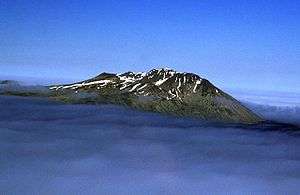Mount Adagdak
Mount Adagdak is a Pleistocene age stratovolcano on the northernmost extremity of Adak Island in the Aleutian Islands, Alaska. Located about 1,180 miles (1,900 km) from Anchorage, the mountain is located about 1.4 kilometers (0.9 mi) south of Cape Adagdak, for which it was named in 1948 by the United States Geological Survey.
| Mount Adagdak | |
|---|---|
 Mount Adagdak in 2000 | |
| Highest point | |
| Elevation | 2,001 ft (610 m) [1] |
| Coordinates | 51°59′16″N 176°35′30″W [1] |
| Geography | |
 Mount Adagdak | |
| Parent range | Aleutian Range[1] |
| Topo map | USGS Adak C-2 |
| Geology | |
| Age of rock | Pleistocene[1] |
| Mountain type | Stratovolcano[1] |
| Volcanic arc/belt | Aleutian Arc |
The volcano is made up of rock from three different periods of activity. The youngest rock was argon dated to between 205,000 - 215,000 years old.[2]
John Hunter of Quicklaunch has twice proposed the use of Mount Adagdak's western slope as the emplacement site for a light-gas gun to launch small payloads into orbit for use at ISS.[3]
See also
- List of volcanoes in the United States of America
- List of stratovolcanoes
References
- "Adagdak". Global Volcanism Program. Smithsonian Institution. Retrieved 2009-01-16.
- "Adagdak - Introduction". www.avo.alaska.edu. Retrieved 2018-06-08.
- Livingston, David (January 15, 2010). "Dr. John Hunter". The Space Show. Archived from the original on July 27, 2011. Retrieved 2011-05-22.
External links
This article is issued from Wikipedia. The text is licensed under Creative Commons - Attribution - Sharealike. Additional terms may apply for the media files.